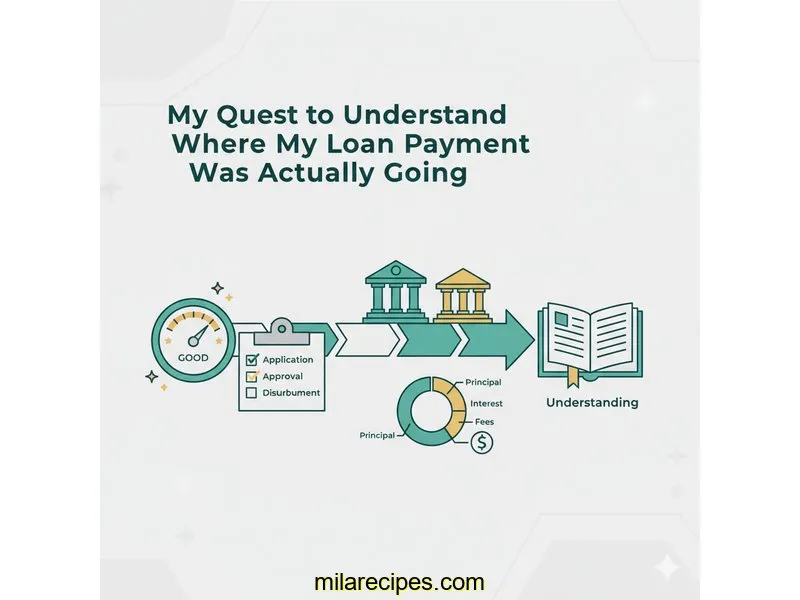
Auto Loan Calculator
Calculate payments over the life of your Loan
Home Blog Privacy Terms About Contact
Calculate payments over the life of your Loan
Home Blog Privacy Terms About ContactPublished on October 26, 2025

My journey into the world of loan calculations didn't start with a big financial goal or a major life decision. It started with a single number on a screen that just didn't make sense to me. I was playing around with an online loan calculator, looking at a hypothetical scenario, and I clicked the button to show the full "Amortization Schedule." It was a huge table of numbers, and one thing immediately jumped out at me.
After the very first monthly payment, the principal balance—the actual amount of the loan—had barely gone down. It felt wrong. If I was making a payment of a few hundred dollars, why did the loan balance only decrease by a fraction of that? Where was the rest of the money going? It was a simple question, but it bugged me immensely. I felt like there was a secret language in these numbers that I didn't understand.
This wasn't about trying to find the "best" loan or save money. My goal was much more fundamental: I wanted to understand the mechanics of a single payment. How could one payment be split into different buckets? How was that split decided? This quest was purely about decoding the math for my own understanding. It became a personal mission to figure out how these calculators arrived at their conclusions, one line item at a time.
So, I decided to document what I found. It’s important to state upfront: This is about understanding how calculations work, not financial advice. My goal is simply to share my learning process, hoping it might help someone else feel a little more confident looking at these numbers too.
My first attempt to solve the mystery was, admittedly, a bit naive. I grabbed a piece of paper and a calculator and started with a simple scenario I'd plugged into the online tool. Let's say the loan was for $11,800 at a 7.4% interest rate, to be paid over 60 months. The online calculator told me the monthly payment would be $234.90.
In my mind, the logic was straightforward. To figure out how much principal I was paying each month, I just needed to divide the total loan amount by the number of payments. So, I did the math: $11,800 divided by 60 months. My calculator showed $196.67. "Okay," I thought, "so about $197 of each payment goes to the principal, and the rest must be interest." The rest was $234.90 - $196.67 = $38.23. So, $38.23 in interest each month. Made sense to me.
But then I looked back at the amortization schedule on the screen. It told a completely different story. For Payment #1, it showed:
I was completely baffled. The interest portion was nearly double what I had calculated, and the principal portion was significantly less. My simple, logical division was totally wrong. How could the interest be so high on the first payment? Why was my version of the math so different from the calculator's? For a moment, I honestly wondered if the online tool was broken or designed to be misleading.
My frustration grew as I scrolled down the table. I saw that by the last payment, the numbers had flipped entirely—almost the entire $234.90 was going to principal, and only a dollar or two went to interest. It was the complete opposite of the first payment. I knew I was missing a core concept. My simple "divide and conquer" method of calculating the principal was not how loans worked at all. I had to go back to square one.

My breakthrough came when I stopped trying to average everything out over the entire loan term. I realized the key must be in how the calculation is performed one month at a time. I decided to try and manually calculate just the very first month's payment breakdown, to see if I could match the online calculator's numbers.
I started with the interest. The annual rate was 7.4%. Since payments are monthly, I reasoned that I first needed to find the monthly interest rate. So, I divided the annual rate by 12: 7.4% / 12 = 0.6167% per month. As a decimal, that's 0.006167.
Then came the "aha" moment. What if the interest isn't calculated on some abstract average, but on the exact remaining balance at the beginning of the month? For the very first payment, the remaining balance was the full loan amount: $11,800. I multiplied that by the monthly interest rate: $11,800 * 0.006167 = $72.77.
It was a perfect match. That was the exact interest figure from the calculator's table. Suddenly, everything clicked into place. The rest was simple subtraction. If the total payment was $234.90 and $72.77 of it was interest, then the principal portion had to be: $234.90 - $72.77 = $162.13. Again, a perfect match. I had cracked the code for a single payment.
This was the foundational step. The formula I learned was: (Current Loan Balance × Annual Interest Rate) / 12. For my $11,800 loan at 7.4%, the first month's interest was ($11,800 × 0.074) / 12, which equals $72.77. This is the cost of borrowing the money for that specific month.
Once the interest was calculated, this part was simple. The formula is: Total Monthly Payment - Monthly Interest = Monthly Principal. Using the numbers, it was $234.90 - $72.77 = $162.13. This is the amount that actually reduces the loan balance.
This is where the magic of amortization happens. The new balance for the start of the second month is the old balance minus the principal you just paid. $11,800 - $162.13 = $11,637.87. Now, for the second payment, the interest calculation would be based on this new, slightly lower balance. ($11,637.87 × 0.074) / 12 = $71.77. Since the interest is now a dollar less, a dollar more of the $234.90 payment goes to principal. This tiny shift happens every single month.
To make sure I really understood, I tried a new scenario from scratch without looking at a calculator first. I imagined a $16,500 loan at 6.1% for 48 months. The monthly payment calculated online was $389.98. Using my newfound knowledge, I calculated the first month's interest: ($16,500 * 0.061) / 12 = $83.88. Then the principal: $389.98 - $83.88 = $306.10. I then checked the online amortization schedule, and my numbers matched perfectly. I finally understood the engine behind the loan.
This entire process was a huge eye-opener. I went from being completely confused by a table of numbers to understanding the precise logic behind every single one. My perspective on loan payments has fundamentally changed. It’s not just about paying a bill; it's about understanding a dynamic process.
Here are the key lessons I learned about the calculations:
Throughout my learning process, I had a lot of questions. Here are a few that I can now answer, based on my journey of understanding the math.
From what I've learned, amortization is the process of paying off a debt over time in regular installments. The key is that each payment is split between interest and principal. The "schedule" is just a table that shows you exactly how that split happens for every single payment until the balance reaches zero.
Because the interest charged each month is based on the outstanding loan balance. At the beginning, your balance is at its highest, so it generates the most interest. As you pay down the principal, the balance shrinks, and the amount of interest charged each month shrinks with it, allowing more of your fixed payment to go toward the principal.
I found them incredibly useful for visualization. You can input your loan amount, interest rate, and term, and it will generate the full schedule. You can then see exactly how much of your first payment goes to interest vs. principal, and how that changes by payment #12, #24, and so on. It turns an abstract concept into a concrete table of numbers.
Generally, no. Making an extra payment reduces your principal balance faster, but your contractually obligated monthly payment usually stays the same. The benefit is that by lowering the principal, you reduce the total interest paid over the life of the loan and pay it off sooner. An amortization calculator with an "extra payments" feature can show you exactly how many payments you might save.
You can use the formula I discovered: (Current Balance × Annual Rate) / 12 = This Month's Interest. If you have your previous month's ending balance and your interest rate, you can calculate what the interest portion should be for the current month. It's a great way to double-check that everything aligns with how amortization math works.
My biggest takeaway from this whole exercise wasn't just learning a formula; it was the feeling of empowerment that came with it. What started as a confusing and intimidating table of numbers is now a clear and logical roadmap. Seeing a loan not as one big, scary debt but as a dynamic balance that changes month by month has made the entire concept feel much more manageable.
I no longer see an amortization schedule as financial jargon. I see it as a story of a loan, showing where every dollar of every payment goes from the first day to the last. My curiosity was satisfied, but more importantly, I gained a new layer of financial literacy that I didn't have before. I'd encourage anyone who has ever felt that same confusion to grab a calculator and just start playing with the numbers. You might be surprised at what you discover.
This article is about understanding calculations and using tools. For financial decisions, always consult a qualified financial professional.
Disclaimer: This article documents my personal journey learning about loan calculations and how to use financial calculators. This is educational content about understanding math and using tools—not financial advice. Actual loan terms, rates, and costs vary based on individual circumstances, creditworthiness, and lender policies. Calculator results are estimates for educational purposes. Always verify calculations with your lender and consult a qualified financial advisor before making any financial decisions.
